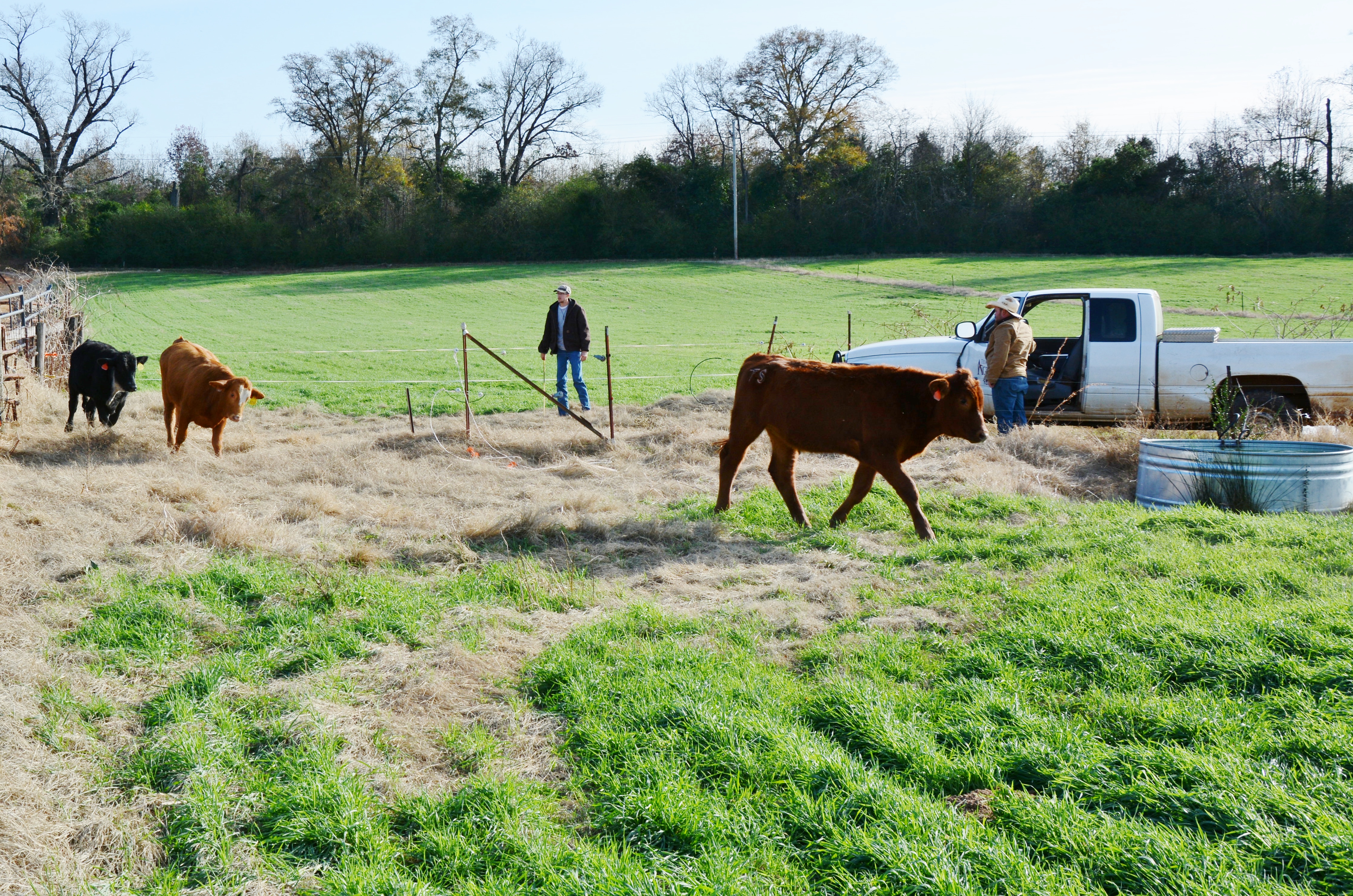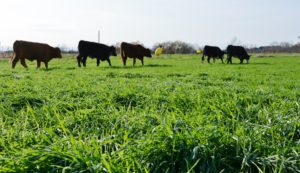Farm & Ranch
[AgriLife Today] Research trials focus on winter pasture stocking strategies

By: Adam Russell
- Writer: Adam Russell, 903-834-6191, [email protected]
- Contact: Dr. Monte Rouquette, 903-834-6191, [email protected]
OVERTON – Profits in stocker production can be as green as winter pastures when conditions are right and producers apply correct stocking strategies, according to a Texas A&M AgriLife Research expert. And research trials at the Texas A&M AgriLife Research and Extension Center in Overton are focusing on identifying optimal strategies and stocking rates for producers.
Dr. Monte Rouquette, an AgriLife Research forage physiologist in Overton, said his research on proper stocking rates for winter pastures considers various hypothetical scenarios producers might face when investing in winter and spring forages.
For producers, success or failure in their investment in small grain and ryegrass seed, planting and fertilizing is determined by the weight gained by each calf and gain per acre by April or May, Rouquette said. The average daily gain, gain per animal and gain per acre will determine whether a producer’s decision to plant winter pastures was worthwhile.
Rouquette said evaluating profits after the fact is always easy but that his goal is to provide producers “advance warning” and expectation for gains from different stocking strategies.
“The research emphasis is to evaluate stocking strategies for stocker cattle and for cows and calves,” he said. “The opportunities are to know the extent of forage growth to expect in the fall, winter and spring, and what kind of stocking rate needs to be used to make appropriate forage utilization. That is where you can make or break an opportunity for profit.”
Rouquette incorporates different stocking strategies, or what he calls treatments, based on the timing of forage production and stocking rates. He may use moderate to light stocking rates and strategies in the fall but then increase the stocking rate in the spring, February through April, to match the forage growth.
“Sometimes we miss the optimum gains with a treatment and sometimes we hit it, but that is what we are looking at, how to optimize the use of the available forage,” he said.
To start his most recent trial, Rouquette recently placed two 600-pound winter-born weaned stocker calves, or 1,200 pounds of bodyweight, per acre on several separate winter pastures of Mayton rye and Nelson ryegrass mix planted in October and fertilized in late November.
Rouquette said the winter pastures are planted with 100 pounds of Mayton rye and 30 pounds of Nelson ryegrass per acre and then receive between 150-200 pounds of nitrogen per acre in split applications.
Winter and spring stocking rates vary with climatic conditions, he said. Experiments with certain forage varieties and/or stocking rates last two to five seasons.
Rouquette’s research has historically involved several different varieties and variety mixtures of forages, including Elbon rye, Gulf and TAM 90 ryegrasses.
The grazing strategies Rouquette incorporates are based on plot data information that has been collected over the past 30 years. This also includes data compiled by forage breeders, forage physiologists and soil fertility researchers at Overton.
The small plot research identifies varieties that are good for East Texas soils and weather conditions, when to plant, when to fertilize, when to initiate stocking and how many animals to stock per acre.
For a more comprehensive look at Rouquette’s stocking strategies go to: http://bit.ly/2iZ29uG.
Previous small plot data suggests that cereal grain rye is the most productive forage during cold winter months, he said.
The rye-ryegrass mix has a minor forage production peak in the fall, Rouquette said, followed by almost no growth in January. But by Feb. 15, when days begin getting longer, and nights and days start to get warmer, the pastures begin what Rouquette calls the “spring flush.”
Rouquette said the winter pastures can produce forage from mid-February through late April to support stocking rates two to three times the fall stocking rate if weather conditions allow and pastures are fertilized properly.
Rouquette said the grazing studies he performs are done with replicated small pastures of about 3-4 acres each.

Stocker calves graze on a lush green Mayton rye and Nelson ryegrass winter pasture. Dr. Monte Rouquette, Texas A&M AgriLife Research forage physiologist, Overton, is researching stocking rates for winter pasture in an attempt to provide producers with information that will produce optimal gains per calf per acre. (Texas A&M AgriLife Extension Service photo by Adam Russell)
Producers have a lot to consider when it comes to maximizing their investment in animals, including forage, he said. Animal health is paramount because a dead animal is a total loss.
There is the cost of cattle, the estimated cost of gains by cattle before sale and eventual price of cattle at market, he said. Producers must also consider what the value of their cattle is in October and what the predicted value will be based on expected gains and the market in April or May.
Producers should expect an average of 2-3 pounds per day gain from calves, but gains depend on stocking rates and the amount of forage available for consumption, Rouquette said.
Too many animals can overgraze a pasture and too few can lead to unused forage, he said.
Producers should have a plan A, plan B and plan C that can be employed if factors such as uncooperative weather or overstocking occur, he said. For instance, moving the cattle to a pasture that is not overseeded where hay or supplements can be provided might be used as a sacrifice area when forage growth cannot provide adequate ration for cattle. This would be better than allowing the winter pasture from being overgrazed below 2-3 inches, which doesn’t produce proper regrowth, especially during the spring flush.
“You’ve got to have an escape route in case you’ve grazed forage too severely,” he said. “Most producers don’t plan to overstock, but if they are not prepared for the next 30 days of weather events and prepared to make adjustments to their stocking rates, they could find themselves in trouble.”
Rouquette said winter grazing requires constant checking and possible adjustments, whether it’s removing or adding cattle, adding fertilizer or moving electric fencing. It’s better to be in a position where cattle are added to adjust to spring flush than removing cattle because pastures are overstocked, he said.
A great indicator of proper stocking rates can be made by a visual appraisal of the height of forage and spot grazing, which means areas of refusal where cattle have defecated and moved to graze other parts of the pasture, Rouquette said.
“Probably the most difficult thing in production is making a stocking rate work,” he said. “But it’s always better to be lightly stocked and have to put more calves and cows in a pasture for adjustment rather than have too many stocker cattle and not have options other than to sell at too light a weight.”
-30-
Find more stories, photos, videos and audio at http://today.agrilife.org
Farm & Ranch
Ag Elsewhere: Wyoming

By Tressa Lawrence
Babies are tucked away in every nook and cranny. Many ranchers across Wyoming have baby animals popping up all over this time of year.
Farm & Ranch
Ag Elsewhere: Montana

By Lindsey Monk
Another load of grain in to keep feeding the calves until the green grass can really start popping.
Farm & Ranch
Meanwhile, Back at the Ranch….

By Rayford Pullen | [email protected]
Spring has sprung and hopefully the rains will continue where our country will heal from the previous droughts and our grasses will thrive. We are especially hopeful for the Panhandle of Texas where our neighbors and friends have been dealt a deadly blow to homes, ranges, livestock, and people. Keep them in your prayers as they will not be able to return to normal for many years if at all. Having lost their ability to benefit from this great cattle market is a double whammy for all of them.
Now is the time of year when we need to take care of business as it relates to our new calves that have been hitting the ground this spring. First and foremost is vaccinating for Blackleg followed by deworming with a white wormer and the IBR complex. Blackleg is a soil-born disease and with pastures extremely short this spring our calves have been grazing the green grass as soon as it shows itself, making them even more vulnerable to picking contaminates from the soil.
To read more, pick up a copy of the April issue of NTFR magazine. To subscribe by mail, call 940-872-5922.
-

 Country Lifestyles1 year ago
Country Lifestyles1 year agoScott & Stacey Schumacher: A Growth Mindset
-

 Equine7 months ago
Equine7 months agoThe Will to Win
-

 Country Lifestyles7 years ago
Country Lifestyles7 years agoStyle Your Profile – What your style cowboy hat says about you and new trends in 2017
-

 Country Lifestyles4 years ago
Country Lifestyles4 years agoAmber Crawford, Breakaway Roper
-

 HOME7 years ago
HOME7 years agoGrazing North Texas – Wilman Lovegrass
-

 Country Lifestyles7 years ago
Country Lifestyles7 years agoDecember 2016 Profile, Rusty Riddle – The Riddle Way
-

 Country Lifestyles8 years ago
Country Lifestyles8 years agoJune 2016 Profile – The man behind the mic: Bob Tallman
-

 Country Lifestyles8 years ago
Country Lifestyles8 years agoCowboy Culture with Clay Reid – Being a Man






